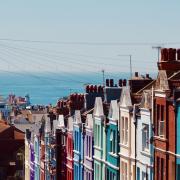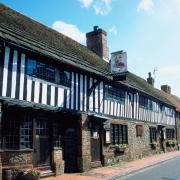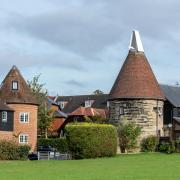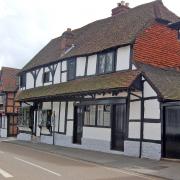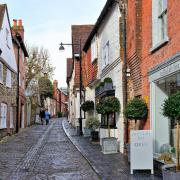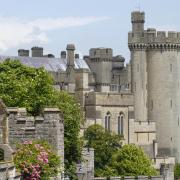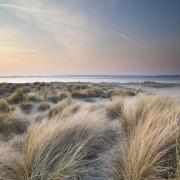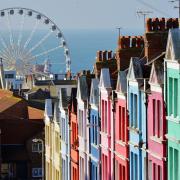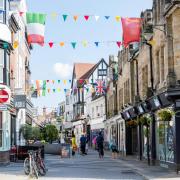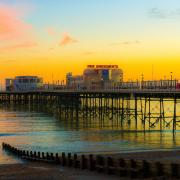On his debut visit to the coastal town we learn about Ian Fleming, Ronnie Barker and the seafront’s longest bench
Despite the welcome winter sunshine, my first-ever visit to Littlehampton isn’t getting off to the best of starts – I can’t find the council offices where I’m supposed to be meeting my escorts. The handsome, white, mid-19th century Manor House that Littlehampton Town Council occupies is far more elegant than the dull municipal block I was looking for. Inside there’s another surprise, a delightful museum.
Terry Ellis, chairman of Littlehampton Heritage Group, and Malcolm Belchamber, a four-time mayor, have kindly agreed to show me around town. Since time is limited and our combined age is 225 or thereabouts, we’re not walking on this occasion but climb into Terry’s car instead.
Whereas Malcolm, a retired estate agent, has lived in Littlehampton all his life, Terry is a comparative newcomer. Together with his wife, he spent two years scouring the south-east of England in search of the ideal place to live and firmly believes he’s found his Shangri-La.
Our first stop is unscheduled. As Terry points to a Dalmatian dog scratching at the first-floor window of a terraced house (bear with me if you will), Malcolm spots the owner feeding seagulls by the harbour wall opposite. Leaving aside the desirability of otherwise of this activity, it’s immediately apparent that Alan McKay is a real character. The three magnificent classic cars parked outside his house, alongside which the three of us feel genuinely youthful, confirm my initial assessment of Alan as, at least, mildly eccentric.
Despite a mild clash with the authorities over the clambering canine, Alan is another huge fan of Littlehampton. “It’s an old-fashioned, family-friendly, seaside resort,” he remarks above the din of squawking seagulls.
Terry takes the car as Malcolm and I cross over the footbridge. It’s partly retractable, slides back when a ship passes on the River Arun below and replaced the previous swing bridge in 1973. A new fixed bridge was built half-a-mile upstream that greatly eased traffic congestion that Malcolm recalls being “pretty dreadful” on a sunny summer Sunday.
Neither of my companions are golfers and so I don’t bother telling them that the course now on our right is the oldest in West Sussex or that the legendary JH Taylor helped design it. The opening of the swing bridge in 1908 increased its accessibility and presented a couple of enterprising local boatmen – Jimmy and Peachey – with an opportunity to cash in by undercutting the bridge toll with a bargain ‘tuppeny return’.
Next to the beach is what remains of Littlehampton Fort, which was built in 1854 to thwart a possible French invasion. A combination of changes in armament technology and a receding threat from the other side of the Channel soon rendered the fort redundant and in 1891 the guns were removed and it was mostly demolished. Unconnected with any possible resumption of post-Brexit, cross-Channel hostility, efforts are underway to at least partially restore it.
During World War II, Littlehampton was a centre for air/sea rescue patrols and the local boatyards turned their skills to producing landing craft. West Beach, which is where we are now, was used by Allied troops for mock landings and in 1944 ships sailed from Littlehampton on D-Day. And Littlehampton was the secret centre of covert operations carried out by 30 Assault Unit. Formed by Commander Ian Fleming, the unit had its headquarters in Selbourne Road. Fleming frequently stayed in the Beach Hotel (now an apartment block) and relaxed in the nearby Marine pub. As well as helping to win the war, Fleming was also gathering material for his later career as author of the James Bond novels.
The town’s considerable contribution to the war effort is perhaps more clearly personified in Jeffrey Quill, who lived in 9 South Terrace. Only the second person ever to fly a Spitfire, he left the RAF in January 1936 to join Vickers as assistant to the chief test pilot. Three months later and three weeks after its maiden flight, he flew a Spitfire for the first time before taking over the following year as its chief test pilot.
Following the fall of France, he rejoined his squadron claiming he needed first-hand combat experience to better understand the plane’s performance.
One of ‘the few’, he shot down two enemy aircraft in the Battle of Britain before returning to Vickers and using his operational experience to introduce at least two significant improvements to the plane.
After his retirement and with an eminently suitable name, Quill picked up a pen and wrote several books including Spitfire: a Test Pilot’s Story and Birth of a Legend: the Spitfire. He died in 1996. The strong military connection possibly explains why, apart from Portsmouth, every year Littlehampton puts on the south coast’s largest Armed Forces Day.
On a significantly lighter note, just a few doors down from where Quill lived is the former home of writer and comedian Ronnie Barker, who drew inspiration from the area – especially Coopers, a shop around the corner that’s now Londis – to create the popular TV series Open All Hours.
With an estate agent’s instinct for what confers appeal on an area, Malcolm points out that South Terrace is set well back leaving a large, open, grassy area between the elegant Regency houses and the sea, which both locals and visitors can enjoy.Drawn by its magnetic appeal, we wander down to the water where I’m assured the shingle beach gives way to glorious golden sand when the tide retreats.
Apparently people come from all over the world to visit the extraordinary-looking East Beach Café. The architecture is remarkable and, if the reviews are to be believed, so is the food.
Another curiosity stretches right the way along the magnificent promenade from the café almost to the harbour mouth. Dipping, twisting and turning as it goes, the aptly named Long Bench is 1,000ft long and can accommodate more than 300 people simultaneously sitting on it. A couple of hundred of the recycled hardwood slats are officially engraved with messages and memories. It costs £150 to have one done and the proceeds go to a worthy charity, the Aldingbourne Trust.
On the subject of money, a generous donation by the family of Anita Roddick largely paid for the bench.
The founder of The Body Shop was born and raised in Littlehampton where her Italian parents ran an ice-cream parlour and, despite the opportunity to ‘upgrade’, chose to stay living in their original home.
The Body Shop still has a town office that looks after Europe, the Middle East and Africa.
If Anita Roddick is the town’s most celebrated former resident, the Blue Peter lifeboat is perhaps what it’s most famous for.
The first of many lifeboats bought with money raised by viewers of the popular TV programme, it was handed over at the re-opened lifeboat station in 1967.
There’s no shortage of fun to be had in Littlehampton and a little way from the lifeboat station is Oyster Pond.
Now an ornamental lake upon which toy boats scud about in summer, it was where fisherman used to store the shellfish they caught.
Next door is Harbour Park, a popular amusement park run by Gary Smart, a descendant of the famous Billy Smart.
The miniature railway that runs parallel to the promenade is not only a very rare 12¼ in gauge but also the oldest of only six in existence.
Aware of my fondness for quirky facts, Malcolm and Terry take me to Bayford Road for our final stop. Numbers 17 to 137 Bayford Road are the longest stretch of uninterrupted terrace housing in England, allegedly.
More…
• We went to find out more on the history of Rottingdean - Contraband goods provided a valuable source of income for Rottingdean in years past, and a number of illustrious figures have made it their home since then as Clive Agran discovers




